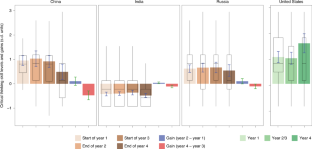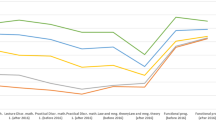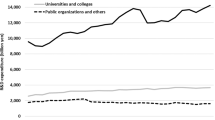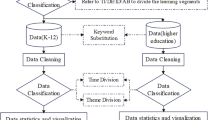Abstract
Universities contribute to economic growth and national competitiveness by equipping students with higher-order thinking and academic skills. Despite large investments in university science, technology, engineering and mathematics (STEM) education, little is known about how the skills of STEM undergraduates compare across countries and by institutional selectivity. Here, we provide direct evidence on these issues by collecting and analysing longitudinal data on tens of thousands of computer science and electrical engineering students in China, India, Russia and the United States. We find stark differences in skill levels and gains among countries and by institutional selectivity. Compared with the United States, students in China, India and Russia do not gain critical thinking skills over four years. Furthermore, while students in India and Russia gain academic skills during the first two years, students in China do not. These gaps in skill levels and gains provide insights into the global competitiveness of STEM university students across nations and institutional types.
This is a preview of subscription content, access via your institution
Access options
Access Nature and 54 other Nature Portfolio journals
Get Nature+, our best-value online-access subscription
$29.99 / 30 days
cancel any time
Subscribe to this journal
Receive 12 digital issues and online access to articles
$119.00 per year
only $9.92 per issue
Buy this article
- Purchase on Springer Link
- Instant access to full article PDF
Prices may be subject to local taxes which are calculated during checkout


Similar content being viewed by others
Data availability
Data have been deposited at the Open Science Framework (https://osf.io/4t8cu/).
Code availability
Stata do-files used to perform the analyses have been deposited at the Open Science Framework (https://osf.io/4t8cu/).
Change history
06 April 2021
A Correction to this paper has been published: https://doi.org/10.1038/s41562-021-01102-y
References
National Academies of Sciences, Engineering, and Medicine. Indicators for Monitoring Undergraduate STEM Education (National Academies Press, 2017).
Mayhew, M. J. et al. How College Affects Students Volume 3: 21st Century Evidence that Higher Education Works (Jossey-Bass, 2016).
Criteria for Accrediting Engineering Technology Programs (ABET, 2015); www.abet.org/wp-content/uploads/2015/10/T001-16-17-ETAC-Criteria-10-16-15.pdf
Passow, H. J. Which ABET competencies do engineering graduates find most important in their work? J. Eng. Educ. 101, 95–118 (2012).
National Research Council. Education for Life and Work: Developing Transferable Knowledge and Skills in the Twenty-First Century (National Academies Press, 2012).
Arum, R. & Roksa, J. Academically Adrift: Limited Learning on College Campuses (Univ. Chicago Press, 2011).
AAC&U. How Should Colleges Assess and Improve Student Learning? Employers’ Views on the Accountability Challenge (AAC&U, 2008).
National Academy of Science. Rising Above the Gathering Storm: Energizing and Employing America for a Brighter Economic Future (National Academy of Science, 2005).
Goldin, C. D. & Katz, L. F. The Race Between Education and Technology (Harvard Univ. Press, 2009).
Autor, D. H., Levy, F. & Murnane, R. J. The skill content of recent technological change: an empirical exploration. Q. J. Econ. 118, 1279–1333 (2003).
Bresnahan, T. F., Brynjolfsson, E. & Hitt, L. M. Information technology, workplace organization, and the demand for skilled labor: firm-level evidence. Q. J. Econ. 117, 339–376 (2002).
Katz, L. F. & Krueger, A. B. Computer science inequality: have computers changed the labor market? Q. J. Econ. 113, 1169–1213 (1998).
Lucas, R. E. On the mechanics of economic development. J. Monetary Econ. 22, 3–42 (1988).
Romer, P. M. Endogenous technological change. J. Polit. Econ. 98, S71–S102 (1990).
Mankiw, N. G., Romer, D. & Weil, D. N. A contribution to the empirics of economic growth. Q. J. Econ. 107, 407–437 (1992).
Murnane, R. J., Willett, J. B. & Levy, F. The growing importance of cognitive skills in wage determination. Rev. Econ. Stat. 77, 251–266 (1995).
Hanushek, E. A. & Kimko, D. D. Schooling, labor-force quality, and the growth of nations. Am. Econ. Rev. 90, 1184–1208 (2000).
Hanushek, E. A. & Woessmann, L. The role of cognitive skills in economic development. J. Econ. Lit. 46, 607–668 (2008).
Hanushek, E. & Woessmann, L. Do better schools lead to more growth? Cognitive skills, economic outcomes, and causation. J. Econ. Growth 17, 267–321 (2012).
Hanushek, E. & Woessmann, L. Schooling, educational achievement, and the Latin American growth puzzle. J. Dev. Econ. 99, 497–512 (2012).
Kaarsen, N. Cross-country differences in the quality of schooling. J. Dev. Econ. 107, 215–224 (2014).
Heckman, J., Stixrud, J. & Urzua, S. The effects of cognitive and noncognitive abilities on labor market outcomes and social behavior. J. Labor Econ. 24, 411–482 (2006).
Deming, D. & Kahn, L. B. Skill requirements across firms and labor markets: evidence from job postings for professionals. J. Labor Econ. 36, S337–S369 (2018).
World Bank. World Development Report 2018: Learning to Realize Education’s Promise (World Bank, 2018).
Loyalka, P. et al. Factors affecting the quality of engineering education in the four largest emerging economies. High. Educ. 68, 977–1004 (2014).
Musekamp, F. & Pearce, J. Assessing engineering competencies: the conditions for educational improvement. Stud. High. Educ. 40, 505–524 (2015).
Zlatkin-Troitschanskaia, O., Shavelson, R. J. & Kuhn, C. The international state of research on measurement of competency in higher education. Stud. High. Educ. 40, 393–411 (2015).
OECD. Assessment of Higher Education Learning Outcomes (AHELO) Feasibility Study Report—Volume 2 Data Analysis and National Experiences (OECD, 2012).
Loyalka, P. et al. Computer science skills across China, India, Russia, and the United States. Proc. Natl Acad. Sci. USA 116, 6732–6736 (2019).
OECD. Education at a Glance 2018 (OECD, 2018).
Montenegro, C. E. & Patrinos, H. A. Comparable Estimates of Returns to Schooling Around the World (World Bank, 2014).
Spence, M. Job market signaling. Q. J. Econ. 87, 355–374 (1973).
Moretti, E. Estimating the social return to higher education: evidence from longitudinal and repeated cross-sectional data. J. Econ. 121, 175–212 (2004).
Aghion, P., Howitt, P., Howitt, P. W., Brant-Collett, M. & García-Peñalosa, C. Endogenous Growth Theory (MIT press, 1998).
Nelson, R. R. & Phelps, E. S. Investment in humans, technological diffusion, and economic growth. Am. Econ. Rev. 56, 69–75 (1966).
Benhabib, J. & Spiegel, M. M. Human capital and technology diffusion. Handb. Econ. Growth 1, 935–966 (2005).
Katz, L. F. & Murphy, K. M. Changes in relative wages, 1963–1987: supply and demand factors. Q. J. Econ. 107, 35–78 (1992).
Autor, D. H., Katz, L. F. & Krueger, A. B. Computing inequality: have computers changed the labor market? Q. J. Econ. 113, 1169–1213 (1998).
National Science Board. Science and Engineering Indicators 2016 (National Science Foundation, 2016).
Bourdieu, P. Homo Academicus (Stanford Univ. Press, 1988)
Shavit, Y., Arum, R. & Gamoran, A. (eds) Stratification in Higher Education: A Comparative Study. (Stanford Univ. Press, 2007).
Altbach, P. G. & Salmi, J. (eds) The Road to Academic Excellence: The Making of World-Class Research Universities (The World Bank, 2011).
Carnoy, M. et al. University Expansion in a Changing Global Economy: Triumph of the BRICs? (Stanford Univ. Press, 2013).
World Bank. World Development Indicators 2018 (World Bank, 2018); http://databank.worldbank.org/data/reports.aspx?source=world-development-indicators
Muralidharan, K., Das, J., Holla, A. & Mohpal, A. The fiscal cost of weak governance: evidence from teacher absence in India. J. Publ. Econ. 145, 116–135 (2017).
Burdett, N. Review of High Stakes Examination Instruments in Primary and Secondary School in Developing Countries Research on Improving Systems of Education (RISE) Working Paper 17/018 (RISE Programme, 2017).
Cheney, G. R., Ruzzi, B. B. & Muralidharan, K. A Profile of the Indian Education System (National Center on Education and Economy, 2005).
Guo, C. B., Tsang, M. & Ding, X. H. Gender difference in the education and employment of science & engineering students in HEIs. J. High. Educ. 11, 89–101 (2007).
Dobryakova, M. & Froumin, I. Higher engineering education in Russia: incentives for real change. Int. J. Eng. Educ. 26, 1032–1041 (2010).
Pal, Y. Report of the Committee to Advise on Renovation and Rejuvenation of Higher Education (Department of Human Resources, Government of India, 2009).
Zha, Q., Hu, L. & Wang, Y. The characteristics of university students’ extracurricular time assignment and its impact on learning outcome: based on China college student survey in J University in 2016. High. Educ. Explor. 7, 44–49 (2017).
Lv, L. & Zhang, H. The characteristics of undergraduates’ learning engagement of Chinese research-oriented university: based on the comparison of 12 research-oriented universities in the world. Educ. Res. 36, 51–63 (2015).
Mandel, H. & Semyonov, M. Gender pay gap and employment sector: sources of earnings disparities in the United States, 1970-2010. Demography 51, 1597–1618 (2014).
Bound, J., Lovenheim, M. F. & Turner, S. Why have college completion rates declined? An analysis of changing student preparation and collegiate resources. Am. Economic J. Appl. Econ. 2, 129–157 (2010).
Bettinger, E. P., Long, B. T., Oreopoulos, P. & Sanbonmatsu, L. The role of application assistance and information in college decisions: results from the H&R Block FAFSA experiment. Q. J. Econ. 127, 1205–1242 (2012).
Stinebrickner, T. & Stinebrickner, R. Learning about academic ability and the college dropout decision. J. Labor Econ. 30, 707–748 (2012).
Glewwe, P. & Kremer, M. Schools, teachers, and education outcomes in developing countries. Handb. Econ. Educ. 2, 945–1017 (2006).
McEwan, P. Improving learning in primary schools of developing countries: a meta-analysis of randomized experiments. Rev. Educ. Res. 85, 353–394 (2013).
Hanushek, E. A. Will more higher education improve economic growth? Oxford Rev. Econ. Pol. 32, 538–552 (2016).
Clark, D. & Martorell, P. The signaling value of a high school diploma. J. Polit. Econ. 122, 282–318 (2014).
Li, H., Meng, L., Shi, X. & Wu, B. Does attending elite colleges pay in China? J. Comp. Econ. 40, 78–88 (2012).
Muralidharan, K. Priorities for Primary Education Policy in India’s 12th Five-Year Plan India Policy Forum Vol. 9, 1–61 (National Council of Applied Economic Research and Brookings Institution, 2013).
Li, H., Loyalka, P., Rozelle, S. & Wu, B. Human capital and China’s future growth. J. Econ. Perspect. 31, 25–48 (2017).
Kouzminov, Y., Ovcharova, L. & Yakobson, L. (eds) How to Increase Human Capital and its Impact on Economic and Social Development (HSE Publishing House, 2018).
Bound, J., Braga, B., Golden, J. & Khanna, G. Recruitment of foreigners in the market for computer scientists in the United States. J. Labor Econ. 33, S187–S223 (2015).
Bound, J., Khanna, G. & Morales, N. Reservoir of foreign talent. Science 356, 697 (2017).
Hanson, G. H. & Slaughter, M. J. in Education, Skills, and Technical Change: Implications for Future US GDP Growth (eds Hulten, C. R. & Ramey, V. A.) 465–494 (Univ. Chicago Press, 2017).
Liu, O. L., Frankel, L. & Roohr K. C. Assessing Critical Thinking in Higher Education: Current State and Directions for Next‐Generation Assessment ETS Research Report Series (ETS, 2014).
Kardanova, E. et al. Developing instruments to assess and compare the quality of engineering education: the case of China and Russia. Assess. Eval. High. Educ. 41, 770–786 (2016).
Acknowledgements
We thank M. Carnoy, J. Cohen, T. Dee, B. Domingue, A. Eble, R. Fairlie, E. Hanushek, B. Kim, S. Loeb, K. Muralidharan, S. Reardon, S. Rozelle, D. Schwartz, S. Sylvia and C. Wieman, and participants at the demography workshop at the University of Chicago, the economics of education workshop at the Teachers College, the South Asia Region Knowledge Exchange Group at the World Bank, KDI School and technical reviewers at ETS for their feedback. We appreciate research funding from E. Li, the Basic Research Program of the National Research University Higher School of Economics and Russian Academic Excellence Project 5–100, and the All India Council for Technical Education. The funders had no role in study design, data collection and analysis, decision to publish or preparation of the manuscript.
Author information
Authors and Affiliations
Contributions
P.L., O.L.L., G.Li, I.C., E.K., N.Y., F.G., L.M., S.H., A.B., T.B. and N.T. designed research. P.L., O.L.L., G.Li, I.C., E.K., N.Y., F.G., L.M., S.H., H.W., Y.L., A.B. and S.K. performed research. P.L., O.L.L., E.K., D.F., L.G., G.Ling, S.K. and Z.S. analysed data. P.L., O.L.L. and I.C. wrote the paper.
Corresponding authors
Ethics declarations
Competing interests
The authors declare no competing interests.
Additional information
Peer review information Nature Human Behaviour thanks Alex Eble, Thomas Luschei and the other, anonymous, reviewer(s) for their contribution to the peer review of this work. Peer reviewer reports are available. Primary Handling Editor: Charlotte Payne.
Publisher’s note Springer Nature remains neutral with regard to jurisdictional claims in published maps and institutional affiliations.
Supplementary information
Supplementary Information
Supplementary Methods, Supplementary References and Supplementary Tables 1–7.
Rights and permissions
About this article
Cite this article
Loyalka, P., Liu, O.L., Li, G. et al. Skill levels and gains in university STEM education in China, India, Russia and the United States. Nat Hum Behav 5, 892–904 (2021). https://doi.org/10.1038/s41562-021-01062-3
Received:
Accepted:
Published:
Issue Date:
DOI: https://doi.org/10.1038/s41562-021-01062-3
This article is cited by
-
Frontier Development and Insights of International Educational Science Research in the journals Nature and Science: a Systematic Literature Review over 40 Years
Science & Education (2024)
-
The Development of School Satisfaction in Chinese Early Adolescents: The Contributions of Peer Liking and Academic Performance
Journal of Youth and Adolescence (2023)
-
Encouraging Young Women into STEM Careers: A Study Comparing Career Intention of Female STEM Students in China and Scotland
Journal for STEM Education Research (2023)
-
On Intellectual Independence: The Principal Aim of Universities in New Zealand
New Zealand Journal of Educational Studies (2022)



